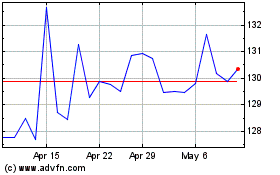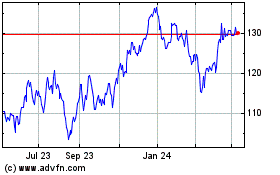Rio Tinto Faces Delays, Added Costs for Big Copper-Mine Project
July 16 2019 - 12:54AM
Dow Jones News
By Rhiannon Hoyle
SYDNEY-- Rio Tinto PLC said it will take longer and cost more
than expected to finish building one of the world's biggest copper
mines in Mongolia's remote southern Gobi desert.
Prospects of an around two-year delay to an underground mine at
the Oyu Tolgoi operation risks worsening a global shortage of
copper that is predicted to deepen in coming years. Copper is an
industrial commodity used in everything from smartphones to
electric cars and power cables, and demand has been rising as
households in China and India become wealthier.
At Oyu Tolgoi, located near Mongolia's border with China where
locals have historically relied on nomadic herding and animal
husbandry, Rio Tinto wants to build a network of underground
tunnels some 4,000-feet deep. That's proven to be increasingly
difficult, with the varying strength of rocks deep below the
Earth's surface heightening a risk of rockfalls.
"The ground conditions are more challenging than expected," said
Stephen McIntosh, Rio Tinto's head of growth and innovation. A new
mining plan probably won't be ready until next year.
Mining safety has become a more-urgent issue in the wake of two
devastating spills of waterlogged waste in Brazil and the deaths of
potentially dozens of miners illegally working on an African copper
mine owned by Glencore PLC.
Oyu Tolgoi is Rio Tinto's biggest new investment, after
management completed a major expansion in Australian iron-ore
production. It represents a big shift in global mining away from
commodities such as coal that powered Asia's first phase of
industrialization to materials used in consumer products.
On Tuesday, Rio Tinto said it may not be able to produce copper
sustainably from the underground pit until possibly as late as June
2023. That represents a delay of up to 30 months from its earlier
forecast, and means the cost of the project could blow out by as
much as US$1.9 billion to US$7.2 billion.
A near-term impact is likely to be on Rio Tinto's net profit,
with management reviewing the carrying value of Oyu Tolgoi and
planning to update investors on Aug. 1 when it is due to release
its half-year result.
Rio Tinto, which manages the Oyu Tolgoi project, has an indirect
interest in the mine. It holds 50.8% of publicly traded Turquoise
Hill Resources Ltd., which in turn controls 66% of Oyu Tolgoi LLC,
the mine's owner. The Mongolian government owns 34%.
The development of Oyu Tolgoi was for a long time overseen by
Jean-Sébastien Jacques before his promotion to chief executive from
head of Rio Tinto's copper unit.
Oyu Tolgoi has a track record of delays--a victim of fraught
talks with Mongolia's government over how to divide profits. While
copper has been produced via an open pit since 2013, Rio Tinto
needs to dig underground to access the most valuable ore.
Management estimate 80% of the value can't be reached directly from
the surface.
When the underground mine is completed, Oyu Tolgoi will be the
world's third-largest copper mine, according to Rio Tinto's
projections.
Rio Tinto believes the world will need the same amount of copper
in the next 25 years that was produced in the previous five
centuries to meet global demand. That estimate is tied to continued
economic growth in China and emerging markets, as well as a rising
global population and a ballooning middle class.
Global copper output totals around 25 million metric tons
annually, but the market is expected to record a deficit of 190,000
tons this year, widening to 250,000 tons in 2020, according to the
International Copper Study Group, an organization of
copper-producing and -consuming countries. Many analysts think that
will deepen next decade.
Rio Tinto's other main copper project, Resolution, a joint
venture with BHP Group Ltd. in Superior, Ariz., isn't expected to
be built until the middle or later part of the next decade. It
recently discovered a copper deposit in Australia, called Winu,
where exploration drilling is continuing.
(END) Dow Jones Newswires
July 16, 2019 00:39 ET (04:39 GMT)
Copyright (c) 2019 Dow Jones & Company, Inc.
Rio Tinto (ASX:RIO)
Historical Stock Chart
From Mar 2024 to Apr 2024

Rio Tinto (ASX:RIO)
Historical Stock Chart
From Apr 2023 to Apr 2024
